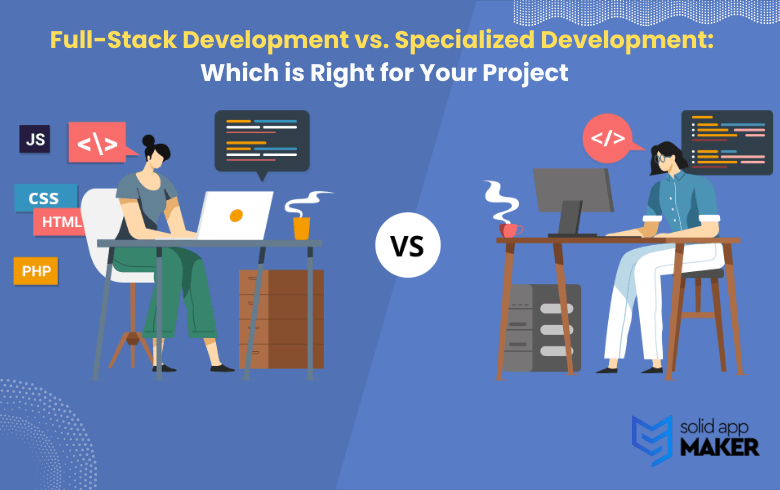Considering web development technology before starting a project is absolutely crucial. It’s like laying a strong foundation for your project’s success. The choice of technology directly impacts the performance, scalability, and security of your website or application.
By selecting the right technology stack, you unlock a world of possibilities and modern tools that can streamline the development process. It also helps you estimate timelines, budget, and resources more accurately, leading to a smoother project experience. Most importantly, aligning the technology with your project’s goals ensures a seamless user experience and sets the stage for long-term growth.
So, when it comes to web development, one crucial decision you’ll face is choosing the right development approach for your project.
Join us on a journey through the fascinating realms of full-stack development and specialized development. In this blog post, we’ll check the differences between these two approaches, equipping you with the knowledge to make an informed decision for your project. By the end, you’ll have a clear understanding of these approaches and be able to determine which one aligns best with your project’s unique requirements.
Understanding Full-Stack Development:
Full-stack development is like being a jack-of-all-trades in the web development world. It involves mastery of both front-end and back-end technologies, allowing developers to handle the entire development process from start to finish. Full-stack developers possess a wide range of skills, including proficiency in programming languages, databases, server management, and UI/UX design. The versatility and efficiency of full-stack development make it an attractive option for many projects.
Exploring Specialized Development:
On the other hand, specialized development focuses on depth rather than breadth. It involves engaging developers with specialized expertise in specific areas, such as front-end development, back-end development, or database management. Specialized developers bring in-depth knowledge and skills to the table, enabling them to deliver optimized solutions tailored to specific project requirements. They excel in their respective domains, ensuring top-notch performance and functionality.
Factors to Consider when Choosing the Right Approach:
When deciding between full-stack development and specialized development, several factors come into play. First, consider the scope, complexity, and requirements of your project. If you’re working on a smaller project with straightforward needs, full-stack development may be a cost-effective choice. However, for larger and more complex projects that demand specialized expertise, a team of specialized developers might be the ideal option. Timeframe, budget, and available resources are also important considerations that can influence your decision-making process.
READ MORE: 14 Points to Consider When Hiring an App Development Company
Evaluating Your Project Needs:
To determine the right approach for your project, carefully evaluate your specific requirements. Consider the key aspects where full-stack development shines, such as small to medium-sized projects with limited resources and tight deadlines. Full-stack developers can handle multiple tasks, ensuring seamless coordination between different components. However, if your project requires advanced front-end interactions, complex database structures, or high-performance back-end systems, specialized development may offer a competitive advantage.
Making the Right Choice:
Making an informed decision requires a thorough analysis of your project’s unique needs and long-term goals. Consider the strengths and weaknesses of both approaches, weighing them against your project’s requirements. Scalability and future development needs should also be taken into account. Don’t hesitate to consult with experts or seek professional advice to gain additional insights that can guide your decision-making process.
Takeaway:
Choosing between full-stack development and specialized development is a critical decision that can significantly impact your project’s success. By understanding the characteristics, benefits, and considerations of each approach, you are well-equipped to make the right choice. Assess your project’s requirements, evaluate the pros and cons, and select the approach that aligns best with your specific needs. Remember, a well-informed decision will pave the way for a successful and seamless development journey.

